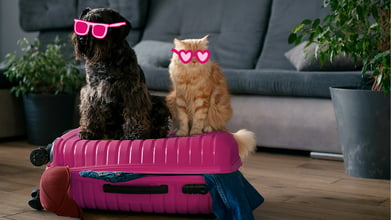Traveling is fun, and with the pandemic (hopefully) winding down, trips are slowly becoming more accessible again. For us pet parents, however, traveling can sometimes mean leaving your furry friend behind. This certainly can put a damper on things, but it doesn’t always have to be the case! Your team at BetterVet has put together some travel tips to help you and your pet take flight safely and successfully, together!
Rules and Regulations
Though rules do vary from airline to airline, your pet can typically only fly in the cabin, a.k.a. as a carry-on with you, if they are small enough to fit in a carrier under the seat in front of you or they are a registered service animal. Furry friends larger than that will have to travel in the cargo hold, with the luggage and freight. Most airlines describe this as “shipping” your pet. (Yikes.)
Flying Fear-Free
While airlines do try their best to make pets comfortable in the cargo hold, it likely isn’t the most pleasant experience. In addition to being separated from you, items might shift or fall during the flight, which can be loud and scary. Furthermore, the cargo hold doesn’t have the same noise cancelling technology that is fitted to the cabin, so the flight itself is noisy in and of itself. For pets who get jumpy with unfamiliar sounds or noises, this may not be the best idea.
How to Prepare to Fly with a Pet
Of course, thousands of pets fly safely in cargo every month! It is just important to keep in mind that it may be a bit uncomfortable for your pet so you can better prepare for the trip!
1. Provide the correct carrier
Regardless of where your pet is flying, The International Air Transport Association has a straightforward checklist for crate requirements, which most airlines adhere to. To summarize it, your crate needs to be durable and have plenty of ventilation, strong handles, and a leak-proof bottom.
Make sure that, like your other luggage, your pet’s carrier has your information attached to it, such as your address, phone number, home address and destination. For pets flying in cargo, it is a good idea to clearly mark your pet carrier with the words “Live Animal” and arrows that show which way is up
2. Consider the cost
Most airlines charge about $125 US for pets to fly in the cabin each way. This fee is waived if the pet is a service animal. For pets traveling via cargo, the price depends on the combined weight of your furry friend and their crate, as well as how far he or she will be flying. Most airlines offer online calculators for getting an estimate.
3. Read the rules
It is important to carefully review the specific guidelines regarding flying with your pet set by the airline you are flying with. While most have similar rules, they can vary, and it is essential to follow all of them in order to avoid any hold up or mishap come travel day.
Some airlines prohibit certain breeds from flying in cargo for safety reasons regarding air pressure. Additionally, certain breeds may be banned from flying in cargo for similar concerns. This is why it is always important to review the guidelines before you book your flight!
4. Choose a non-stop flight
This tip speaks for itself! Non-stop flights are easier for humans and pets alike. It means less stress for you and your pet and requires far less airport time, which can be stressful.
5. Be mindful of weather
This is particularly important if your pet is flying in cargo, as it is not typically as temperature controlled. Consider your destination’s climate: If you’re traveling somewhere warm, look for early morning or late evening flights when the temperatures aren't as high; in cooler climates, choose flights in the middle of the day, when temperatures are warmest.
6. Book your pet in for a BetterVet visit
Most airlines require a health certificate that is no older than 30 days in order for your pet to fly. It is also a good idea to make sure your pet is in good health on a regular basis, regardless of whether or not you are planning to take flight. Pets can’t talk to us to tell us something is wrong, so it’s our job to check for them!
We hope you and your pet have safe travels, whenever and wherever they may be!
Related reading: Traveling with Pets: 10 Ultimate Tips to Consider





